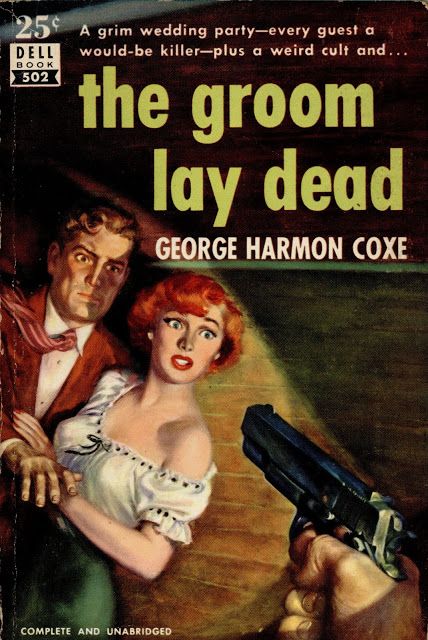Book Review: The Groom Lay Dead by George Harmon Coxe
September 9, 1943: In Europe, the Armistice of Cassibile has been announced, the Italian government having withdrawn from the Axis alliance. (Not that it helped them much because Germany promptly took over much of Italy to fight on.) But in the Finger Lakes region of New York, the war is far away. Alan Wallace, a former theatrical producer and medically discharged Marine, thinks he’s going to have a relaxing week at millionaire Johnny Marshall’s country estate, reading a play Marshall is considering funding.

Once on the train out, however, Alan discovers Johnny has played a cruel trick on him. Mr. Marshall has just married Alan’s ex-fiancée Carol and this is their honeymoon trip. Carol was not aware Alan would be on the train with them, let alone staying in the same house! The cruel millionaire has invited several other people to join them, most of them unhappily.
On the way to the estate, the travelers stop by Mr. Marshall’s vineyard to pick up some wine. A “champagne” (at the time in America, you could legally label domestic sparkling wine as champagne) bottle explodes, sending dangerous glass shards flying. Throughout the remainder of the day, tensions rise. That night, Alan decides to have it out with Johnny, who’s returned to the vineyard. When he arrives, the groom lay dead, apparently the victim of another bottle explosion. Except there’s evidence that suggests Carol was there at the time, and someone slugs Alan unconscious.
The police quickly establish that Johnny Marshall’s death was murder, not accident, and begin investigating. Alan knows that he and Carol (who he still has feelings for) are prime suspects, so decides to do some digging of his own.
This mystery novel was written by George Harmon Coxe (1901-1984), a fairly prolific and popular author best known for his “Flashgun” Casey (photographer-detective) stories. This is a one-off story that doesn’t have any of his serialized characters.
As usual in this sort of story, there’s a lot of potential suspects. Carol, the widow who might have gotten greedy when she realized the man she married was not the one she fell in love with. Alan, the wounded veteran with battle fatigue (we’d call it PTSD these days.) Helen, Johnny’s sister he was trying to have declared incompetent so he could grab her share of their money. Eddington, her lawyer who’d be out his best client if she were disinherited. Earl Garlin, the bodyguard and former private eye. Linda Jordan, the secretary who had been with Johnny the longest and seen off his four previous wives (divorce.) Spencer Haughton, a playwright Marshall had over a barrel because of an exclusive contract. Doctor Samson Penzance, a hypnotist who runs a nearby health camp/cult and his two slightly sinister underlings the Talmains. Oh, and Bert Donelly, the quietly competent caretaker of the estate, who seems entirely unemotional about his employer’s death.
In addition to most of these folks having motives, they all have secrets ranging from embarrassing to actual crimes, so are concealing information from the police or outright lying to them and each other. Alan himself breaks several laws in the course of his amateur detective efforts. Alan is 99.99% sure he isn’t the killer, but possible symptoms of his condition include amnesic blackouts during which he might be murderous.
Alan having to struggle with mental illness is an interesting part of his character. His fear that he’ll never be “well” caused him to break his engagement to Carol, and although he’s doing much better now, there’s moments where he’s less than fully assured of his sanity/emotional stability. The hole in his leg is also sometimes an issue.
There’s plenty of twists and turns, including a seeming solution that comes several chapters too soon to actually be the answer.
One of the things that really stood out to me was the culture of alcohol in the book. Alan and the other characters (with the exception of Dr. Penzance) are constantly fixing drinks, ordering drinks, or imbibing. The vineyard and its wine aging/storing facility is a major part of the setting, and no one is concerned with anyone else’s state of inebriation aside from a minor character’s shrewish wife. The social habit of offering and accepting alcohol even becomes a plot point in the ending.
Content note: Murder, naturally. Alcohol use and abuse. Implied marital infidelity. Male and female nudity–it’s a plot point. A bit of period ableism, particularly involving mental illness.
This novel is a prime example of mid-list mystery fiction of the 1940s. Competent writing and a few decent ideas, but not a soaring example of fine prose. I was fortunate enough to get hold of the Dell edition, with maps of the Finger Lake district and the layout of the estate on the back. It’s been reprinted a few times, so you may be able to find it at a library or used book store. Recommended to fans of hard-boiled mystery fiction.

